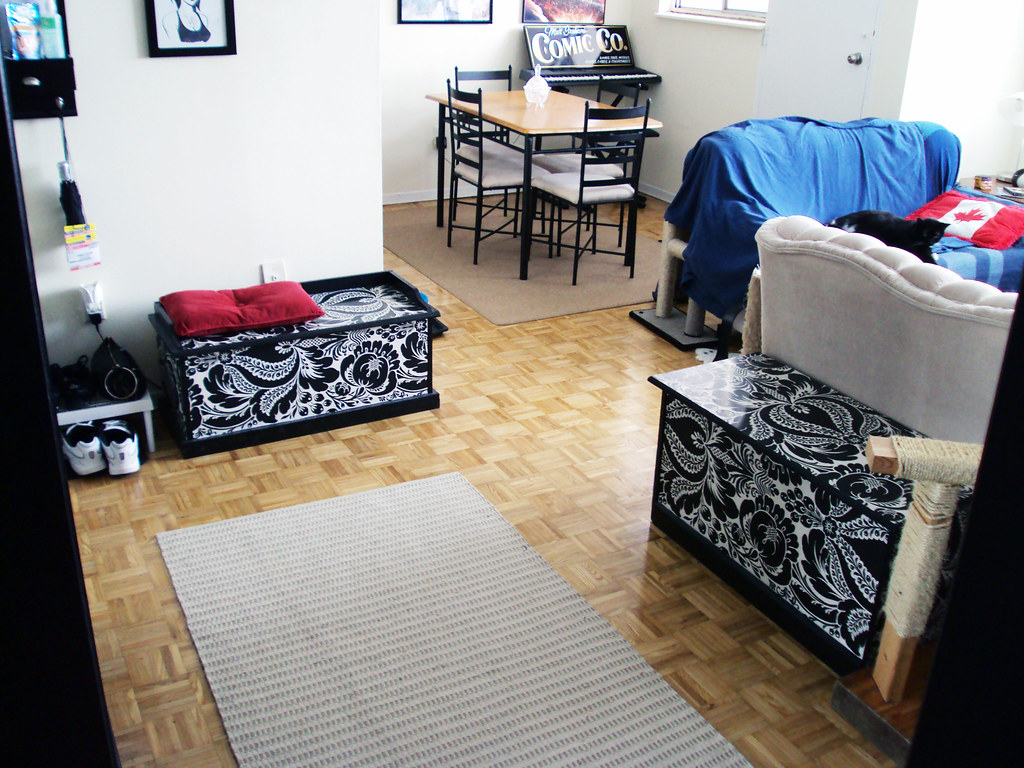 Kitty litter boxes are a difficult thing to hide when you have a small apartment.
Kitty litter boxes are a difficult thing to hide when you have a small apartment.
When my partner and I decided to move, of course our cats came too. But our old apartment was a palace to them. Two floors, 1400 square feet, giant windows with giant windowsills, and an awesome wrought-iron spiral staircase that they ran up and down, doing laps around the apartment.
When it was time to move, they did almost everything to make sure we knew they didn’t want to go. (Homoton sat in the boxes we were trying to pack with this look of, “oh, you wants me to movez?” and went a little nuts when we tried to get him in his very spacious carrying case.) But, the move happened, and eight months and a couple of DIY projects later, they are spoiled and happy in their new 950 square foot home just outside of Toronto.
And these are their new poop boxes. No, really! Those pretty damask benches that are right in our front entryway are the bathroom for our little furry ones.
Stealth Mode Litter Boxes
While in our old apartment, our kitchen was big enough to keep regular plastic litter boxes in a tiled corner behind our counter, but our new apartment has no such space.
 Our nice, unsuspecting entryway cabinet is a secret kitty bathroom
Our nice, unsuspecting entryway cabinet is a secret kitty bathroom
Our house isn't very big, and the place that makes the most sense to put the litter box is right in the front entryway. Instead... Read more
Inspired by some of the beautiful litter box DIY hacks that I saw on the Modern Cat blog, I headed out to the local thrift stores in search of something I could use.
I found two nearly matching bench boxes, one at the Salvation Army thrift store, and the other at a Goodwill. Both were about $10. I set up a workshop in my parents’ garage. My dad cut square holes on one end of each bench, sanded the edges and lined them with super-tacky electrical tape. My mom and I worked at covering them with wallpaper, and painting the edges black with toxic-free, kid-safe paint.
I measured the inside dimensions and found two plastic buckets that were 12″ wide and 4″ high — high enough to have a decent amount of litter inside and short enough that they could step into the box when the lid of the bench was down. Originally, I had litter track mats lining the bottom, but they were ripping them to shreds with their claws. As an easy-to-clean alternative for catching litter before it ended up on my hardwood floors, I found 12″ x 18″ black bar mats on Amazon, which have done the trick perfectly! The rubber is too heavy for cats to demolish with their claws, and the mat catches small litter pebbles in its grooves, which are easy to clean out with the vaccuum or a quick rinse.
Functional AND practical! The benches are great for putting on our shoes, or resting bags and other things as we come in the front door.
Scratching Posts
In pricing out a new, ready-made scratch post and tower, I decided it would be way more economical to make one ourselves.
My dad was excited to help. He found great blocks of wood in our garage and built this super sturdy structure. I wrapped the wood in sisal rope using non-toxic wood glue.
The scratch post cost us about $5 to make. We rubbed a little bit of catnip into the sisal so the cats were attracted, and its existence has definitely saved the back of our couch! Emily thinks it belongs only to her, but they’re pretty good with sharing.
Even though this place is smaller, the cats seem very pleased with their living arrangements. However, I’ve noticed that they’re not as active with less space. My next project is to install strategically-placed carpet-covered shelves to encourage them to move more. The vet told us Homoton needs to lose three pounds, so it’s time to get jumping!





Just found this via Hauspanther. Those are great! Very nice.